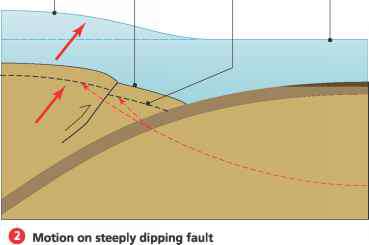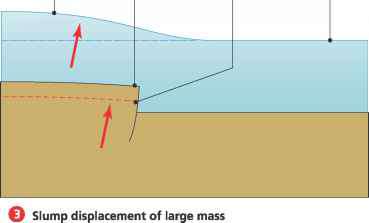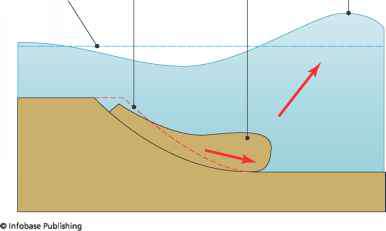Volcanic Eruptioninduced Tsunamis
Some of the largest recorded tsunamis have been generated by volcanic eruptions. These may be associated with the collapse of volcanic slopes, debris and ash flows that displace large amounts of water, or submarine eruptions that explosively displace water above the volcano. Approximately 20 percent of volcanic-induced tsunamis form when volcanic ash orpyroclastic flowshit the ocean, displacing large amounts of water, and 20 percent form from earthquakes associated with the eruption. About 15 percent result from eruptions beneath the water, and 7 percent result from collapse of the volcano and landslides into the sea. The remaining causes are not known. The most famous volcanic eruption-induced tsunamis include the series of huge waves generated by the eruption ofKrakatauin 1883, which reachedrun-upheights of 130 feet (36 m) and killed 36,500 people. The number of people that perished in theeruption of Santoriniin 1600 b.c.e. is not known, but the toll must have been huge. The waves reached 800 feet (240 m) in height on islands close to the volcanic vent of San-torini. Flood deposits have been found 300 feet (90 m) above sea level in parts of the Mediterranean Sea and extend as far as 200 miles (320 km) southward up the Nile River. Several geologists suggest that these were formed from a tsunami generated by the eruption of Santorini. The floods from this eruption may also, according to
O Uplift of broad area of seafloor
Tsunami sea Displaced seabedFormer seabedFormer surface surface surface sea level
Tsunami sea Displaced seabed Former seabed Former surface surface surface sea level
-

- Tsunami sea Displaced seabed Former seabed Former surface surface surface sea level
-

- Former Former seabed Slumped seabed Tsunami sea sea level surface surface surface

some scientists, account for some historical legends such as the great biblical flood, the parting of the Red sea during the exodus of the Israelites from Egypt, and the destruction of the Minoan civilization of the island of Crete.
火山喷发的具体机制s can form tsunami are diverse but number fewer than a dozen. Perhaps the most common is from earthquakes associated with the volcanism. Many volcanic eruptions are accompanied by swarms of moderate-sized earthquakes, and some of these may be large enough to trigger tsunamis. This is especially true in cases of volcanoes built at convergent margins and that are partway under sea level, such as Mount Vesuvius in italy. The79 c.e.eruption of Vesuviuswas associated with manyearthquake-induced tsunamis, some being triggered before the main eruption, and others during and after the eruption.
When pyroclastic flows or nuées ardentes surge down the slopes of volcanoes they may eventually reach the ocean, where they displace water and spread laterally. some pyroclastic flows areless dense than waterand produce layers of ash and pumice that ride over the ocean surface, whereas others are denser than seawater and can suddenly displace large volumes of water, producing a tsunami. in these cases, the larger the flow, the larger the resulting tsunami. some pyroclastic flows are dense, and continue to flow in a surgelike manner on the seafloor, pushing a wall of water ahead of the flow, thus generating a tsunami. The August 26, 1883, eruption of Krakatau in indonesia generated an 33-foot- (10-m-) high tsunami by such an undersea surge of a pyroclastic flow, whereas the march 5, 1871, eruption of Ruang volcano, also in indonesia, produced an 82-foot- (25-m-) high tsunami by this mechanism.
submarine eruptions in shallow water can generate tsunamis by displacing water when the volcano erupts. When the water is deeper than about 1,650 feet (500 m), the weight of the water is so great that it suppresses the formation of surface waves. This is fortunate, since there are many volcanic eruptions along the 8,900-foot- (2,700-m-) deep mid-ocean ridges, and if each of these generated a tsunami, the coastal zone on most continents would be constantly plagued with tsunamis. When submarine eruptions expose the magma chamber of a volcano to seawater, larger tsunamis result from the sudden steam explosion as the cold seawater vaporizes immediately after touching the extremely hot magma. An explosion of this sort generated the deadly 1883 tsunami from the eruption of Krakatau in indonesia, when a steam explosion formed a 130-foot (40-m) high tsunami that killed tens of thousands of people.
one of the most catastrophic ways to bring large volumes of seawater into sudden contact with a magma chamber is through the formation of a caldera, where the top of the volcanic complex suddenly collapses into the magma chamber, forming a large depression on the surface. If the volcano is located at or near sea level, ocean waters can suddenly rush into the depression, where they will encounter the hot magma and form giant steam eruptions. Many volcanoes around the Pacific Rim have formed caldera structures, and many appear to have generated tsunamis. The most famous is the tsunami associated with the formation of the caldera on Krakatau in 1883, in which the tsunami devastated the sunda straits, killing thousands of people. Another example of a tsunami generated by the seawater rushing into a collapsing caldera is from mount Ritter, in Papua New Guinea. on march 13, 1888, a 1.5-mile- (2.5-km-) wide caldera collapsed beneath the volcano, and the sea rushed in, generating a 50-foot- (15-m-) high tsunami that swept local shores. The actual amount of seawater displaced in tsunamis formed by caldera collapse is small, typically many orders of magnitude smaller than the amount displaced during large earthquakes. Therefore tsunamis associated with caldera collapse tend not to travel very far, but to decay in height quickly, according to the inverse of the square root of the distance from the source.
Tsunamis can be generated from volcanoes during collapse of the slopes and formation of landslides and debris avalanches that move into the ocean. most tsunamis generated by the collapse of slopes of volcanoes are small, localized, and very directional, in that they propagate directly away from the landslide or debris avalanche and fade rapidly in other directions. many volcanoes around the Pacific Rim have steep slopes near the sea and pose hazards for tsunamis generated by slope collapse. some of these can be locally quite powerful, as shown by the example of mount unzen in Japan. on may 21, 1792, a large debris avalanche that roared off the slope of the volcano traveled four miles (6.5 km) and hit the seawater of the Ariake sea. This displaced enough water to generate a tsunami withrun-upheights of up to 170 feet (55 m) along a 50-mile- (77-km-) long section of coast on the shimabara Peninsula, killing 14,524 people, destroying 6,000 homes, and sinking 1,650 ships. other volcanic islands, such as Hawaii and the Canary islands, pose a different kind of landslide threat, in which large sections of the volcano collapse, forming giant undersea landslides with associated tsunamis.
A final way that volcanoes can form tsunamis is through lateral blasts or sideways eruptions from the volcano. The most famous lateral blast from a volcano is the well-documented 1980 eruption of mount st. Helens, but this was far from the ocean and did not generate a tsunami. Some volcanoes have a tendency to erupt sideways, one of these being Taal volcano in the Philippines, in which at least five lateral blasts have occurred in the past 250 years, each generating a deadly tsunami.
物质坡移过程on volcanic slopes have generated a number of other tsunamis, but these can generally be classified as being caused by landslides, or as one of the mechanisms from movement of lava discussed in this section. Mudflows and lahars have generated many local tsunamis; lava flows, if large and fast enough, can also generate local tsunamis. Most of these minor mechanisms generate only small, localized, and strongly directional tsunamis.
Continue reading here:Landslideinduced Tsunamis
Was this article helpful?
Readers' Questions
-
wolfgang3 months ago
- Reply
-
giuseppa3 months ago
- Reply
-
arcangelo3 months ago
- Reply

